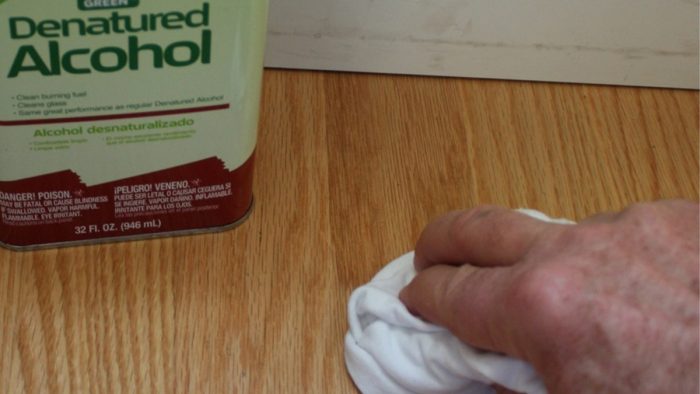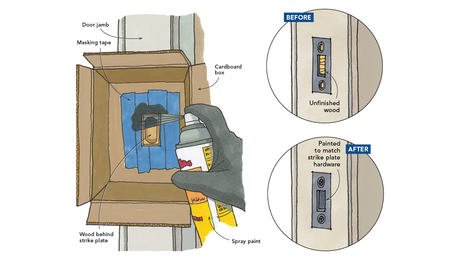
Petroleum-based
Go to the solvents section of a hardware store or home center to look for paint thinner, and you may be confused by the choices. Solvents that are great for thinning oil-based paint may be right next to ones that are best suited for cleaning paint- or grease-covered tools. Although these solvents are all products of petroleum distillation, they’re not the same.
Mineral Spirits
Often labeled as “paint thinner,” this is the most common solvent used in painting. It’s inexpensive, its toxicity level is low, and it has a low evaporation rate. In general, if the paint is going on with a brush or a roller, a lower evaporation rate is best; if it’s going to be sprayed, a higher rate is preferred.
VOC: 780 grams per liter (g/l)*
Health: 1**
Flammability: 2
$5.70 to $6.50/qt.
Odorless Mineral Spirits
The minimal odor of this product is achieved by removing aromatic and sulfur compounds during distillation. The result is a somewhat less powerful solvent than regular mineral spirits, but one that is still adequate for most of the same jobs. Odorless mineral spirits are especially good for indoor use. Even though this product has little odor, it still has a high VOC level, however, making adequate ventilation every bit as important as with any other solvent.
VOC: 790 g/l
Health: 1
Flammability: 2
$6.30 to $7/qt.
Naphtha
Often marketed as “VM&P naphtha” (varnish makers and painters), naphtha evaporates faster than mineral spirits. It therefore promotes faster drying of paint so that a second coat can go on quicker and prevents runs when mixed with paint applied with a sprayer. Less oily than mineral spirits, it’s better at cleaning up greasy residue.
VOC: 750 g/l
Health: 1
Flammability: 3
$7.50 to $10/qt.
Toluene
This sweet-smelling solvent has a high evaporation rate. Although it can be used as a thinner for paint, its toxicity, flammability, and VOC content mean that it must be used with an extra bit of care. Its best use is removing certain adhesives (e.g., vinyl flooring adhesive) and for cleaning tools after use.
VOC: 880 g/l
Health: 2
Flammability: 3
$7.80 to $8.50/qt.
Xylene
This product is similar to toluene, but with a lower evaporation rate.
VOC: 870 g/l
Health: 2
Flammability: 3
$7.80 to $9.50/qt.
Nonpetroleum-based
With the exception of turpentine, the following solvents are not typically used as paint thinners. As with petroleum-based solvents, health and flammability ratings are from the NFPA. Because these solvents are all highly flammable, be sure to store unused amounts in sealed containers.
Acetone
Its high evaporation rate makes it a poor thinner for paint, but acetone can be used to thin epoxies, adhesives, and lacquers. It’s also great at removing coatings such as ink and contact cement, it softens old caulk, and it cleans up uncured polyurethane foam. The primary ingredient in most nail-polish removers, acetone is strong stuff and can even damage certain finishes. It can, however, be diluted with water to reduce its strength.
VOC: not regulated by the EPA as a VOC
Health: 1
Flammability: 3
$7 to $9/qt.
Methylethyl ketone (MEK)
MEK can be used in place of acetone when a lower evaporation rate is desired. Unlike acetone, however, MEK has a high VOC level.
VOC: 815 g/l
Health: 1
Flammability: 3
$9.40 to $12/qt.
Denatured Alcohol
This product is mostly ethanol—that is, grain alcohol—but with some additives mixed in to make it undrinkable and, therefore, cheaper than alcohol sold for consumption. Its primary use is as a cleaner for metal and glass, but it also is mixed with shellac flakes to create shellac.
VOC: 800 g/l
Health: 1
Flammability: 3
$5 to $6.70/qt.
*VOCS, or volatile organic compounds, release vapors at room temperature that contribute to smog and that can cause illness after prolonged exposure. For comparison, Kilz Original oil-based primer has a VOC content of 443 g/l; Kilz Low-VOC primer is 344 g/l. Because of stricter VOC regulations in California, some of these products are unavailable there or have different formulations.
**Health and flammability ratings are from the National Fire Protection Association (NFPA). For comparison, asphalt has a health rating of 0; carbon monoxide is rated 4. Hydrogen peroxide has a flammability rating of 0; propane is rated 4.
Photos: Rodney Diaz

























